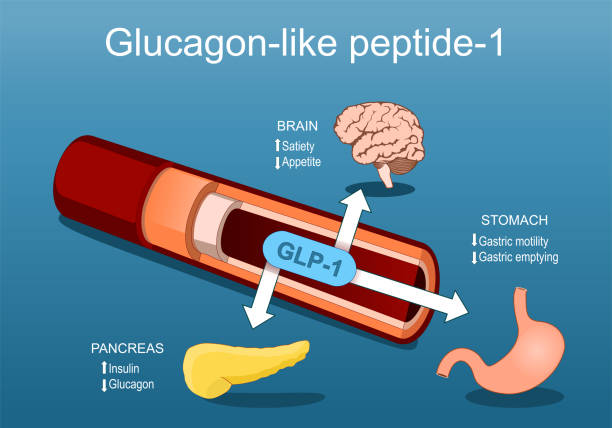Have you ever wondered why you feel full after a meal? It all comes down to processes involving the explaination GLP-1 receptors. But first, what exactly is a GLP-1 receptor?
What are GLP-1 Receptors?
The GLP-1 receptor (GLP1R) is a special protein found on the surface of certain cells in your body (pancreas and brain). Think of it like a “lock” that only opens when the “right key” comes along. When GLP-1 binds to this receptor, it sets off a series of events inside the cell.
GLP1R is produced by a gene located on chromosome 6. It’s part of a family known as G protein-coupled receptors (GPCRs), which are involved in many important bodily functions.
How are GLP-1 Receptors Structured?
The GLP-1 receptor has 2 main parts:
- Extracellular Domain (ECD) – This part sticks out of the cell and is where GLP-1 binds.
- Transmembrane Domain (TMD) – This part goes through the cell membrane and helps send signals inside the cell.
The receptor is like a long string folded into seven loops (alpha-helical transmembrane domains) that go back and forth through the cell membrane. When GLP-1 binds to the ECD, it causes changes in the TMD, which then activates the receptor.

What Does GLP-1 Do?
GLP-1 is a hormone made by your intestines when you eat. What it does are:
- When GLP-1 binds to its receptor on pancreatic beta cells, it boosts the release of insulin, which helps lower blood sugar.
- GLP-1 also reduces the release of glucagon, another hormone that raises blood sugar levels.
- It slows down stomach emptying. By slowing down how fast your stomach empties, GLP-1 makes you feel full longer, helping to control appetite.
- GLP-1 also acts on the brain to reduce hunger and help you feel satisfied after eating.
GLP-1 in the Brain and Body
GLP-1 receptors are not just in the pancreas but also in the brain and other parts of the body. In the brain, these receptors help regulate your appetite and can even improve memory and learning in some cases. GLP-1 receptors are also found in the stomach and intestines, where they help control digestion and communicate with other organs.
How GLP-1 Receptors Work
When GLP-1 binds to its receptor, it activates several signaling pathways inside the cell. Here’s a simplified version of what happens:
GLP-1 binds to the receptor on the cell’s surface. This binding changes the receptor’s shape, activating proteins inside the cell called G proteins. The activated G proteins increase levels of a molecule called cAMP which then activates another protein called PKA, which then helps the cell release insulin. This process helps the body manage blood sugar levels and maintain energy balance.

Why is GLP-1 Important?
GLP-1 as well as GLP-1 receptor agonists (drugs that mimic GLP-1) can help improve blood sugar control and aid in weight management. These drugs are especially useful because they work only when blood sugar levels are high, making them safer and more effective.
One challenge with using GLP-1 is its short lifespan in the body. It breaks down quickly, so researchers have developed longer-lasting versions and drugs that inhibit the enzymes breaking it down. This drugs stay active longer and are therefore able to work more effectively. The benefits of GLP-1 receptor agonists are:
- These drugs help lower blood sugar by increasing insulin release and reducing glucagon release.
- They help reduce appetite and slow down stomach emptying, leading to weight loss.
- Some studies suggest they may also reduce the risk of heart problems.